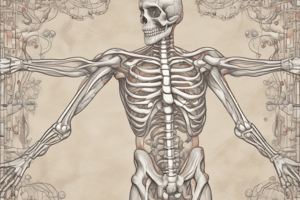Podcast
Questions and Answers
Which pharmacokinetic property of nondepolarizing neuromuscular blocking agents (NMBAs) most significantly contributes to their prolonged duration of action compared to depolarizing agents?
Which pharmacokinetic property of nondepolarizing neuromuscular blocking agents (NMBAs) most significantly contributes to their prolonged duration of action compared to depolarizing agents?
- Their poor lipophilicity, necessitating intravenous administration and resulting in slower elimination. (correct)
- Their high lipophilicity, facilitating rapid distribution into tissues.
- Their ability to be metabolized by plasma cholinesterase.
- Their primary elimination pathway through renal excretion.
In the context of neuromuscular blocking agents (NMBAs), what is the clinical significance of the somatic motor nervous system?
In the context of neuromuscular blocking agents (NMBAs), what is the clinical significance of the somatic motor nervous system?
- It regulates neurotransmitter release at the autonomic ganglia, influencing the duration of action of NMBAs.
- It modulates pain perception and sedation, affecting the patient's awareness during neuromuscular blockade.
- It directly controls skeletal muscles responsible for voluntary movement, which are the primary targets of NMBAs. (correct)
- It controls involuntary functions such as heart rate and digestion, which are indirectly affected by NMBAs.
How does the mechanism of action of nondepolarizing neuromuscular blocking agents (NMBAs) differ from that of depolarizing NMBAs at the neuromuscular junction?
How does the mechanism of action of nondepolarizing neuromuscular blocking agents (NMBAs) differ from that of depolarizing NMBAs at the neuromuscular junction?
- Nondepolarizing NMBAs prevent acetylcholine (ACh) from binding to its receptors, whereas depolarizing NMBAs enhance ACh release.
- Nondepolarizing NMBAs inhibit acetylcholinesterase, increasing ACh concentration, whereas depolarizing NMBAs directly block ACh synthesis.
- Nondepolarizing NMBAs competitively inhibit ACh receptors without activating them, while depolarizing NMBAs cause persistent receptor activation. (correct)
- Nondepolarizing NMBAs cause prolonged depolarization of the postsynaptic membrane, leading to sustained muscle contraction.
What is the primary rationale for using neuromuscular blocking agents (NMBAs) in conjunction with mechanical ventilation?
What is the primary rationale for using neuromuscular blocking agents (NMBAs) in conjunction with mechanical ventilation?
In a patient with combined hepatic and renal failure, which neuromuscular blocking agent (NMBA) would be the MOST appropriate choice, and why?
In a patient with combined hepatic and renal failure, which neuromuscular blocking agent (NMBA) would be the MOST appropriate choice, and why?
Which of the following best explains why acetylcholinesterase inhibitors, such as neostigmine, can reverse the effects of nondepolarizing neuromuscular blocking agents (NMBAs)?
Which of the following best explains why acetylcholinesterase inhibitors, such as neostigmine, can reverse the effects of nondepolarizing neuromuscular blocking agents (NMBAs)?
What is the MOST critical physiological consequence of administering a neuromuscular blocking agent (NMBA) during rapid sequence intubation (RSI)?
What is the MOST critical physiological consequence of administering a neuromuscular blocking agent (NMBA) during rapid sequence intubation (RSI)?
Why might additional boluses of a nondepolarizing neuromuscular blocking agent (NMBA) appear more potent after normal neuromuscular conduction returns?
Why might additional boluses of a nondepolarizing neuromuscular blocking agent (NMBA) appear more potent after normal neuromuscular conduction returns?
How do nondepolarizing neuromuscular blocking agents (NMBAs) affect the autonomic nervous system, and what are the potential clinical implications of these effects?
How do nondepolarizing neuromuscular blocking agents (NMBAs) affect the autonomic nervous system, and what are the potential clinical implications of these effects?
What is the significance of Hofmann degradation in the context of neuromuscular blocking agents (NMBAs), and which agent relies on this process for metabolism?
What is the significance of Hofmann degradation in the context of neuromuscular blocking agents (NMBAs), and which agent relies on this process for metabolism?
A patient with myasthenia gravis requires neuromuscular blockade for a surgical procedure. How would this condition influence the choice and administration of neuromuscular blocking agents (NMBAs)?
A patient with myasthenia gravis requires neuromuscular blockade for a surgical procedure. How would this condition influence the choice and administration of neuromuscular blocking agents (NMBAs)?
What is the underlying mechanism by which neuromuscular blocking agents (NMBAs) can reduce intracranial pressure (ICP) in patients with neurological injuries?
What is the underlying mechanism by which neuromuscular blocking agents (NMBAs) can reduce intracranial pressure (ICP) in patients with neurological injuries?
Which factor contributes MOST significantly to the risk of nosocomial pneumonia in patients receiving neuromuscular blocking agents (NMBAs)?
Which factor contributes MOST significantly to the risk of nosocomial pneumonia in patients receiving neuromuscular blocking agents (NMBAs)?
In a patient receiving a continuous infusion of a neuromuscular blocking agent (NMBA), what strategy can be used to assess the adequacy of neuromuscular blockade and prevent over- or under-paralysis?
In a patient receiving a continuous infusion of a neuromuscular blocking agent (NMBA), what strategy can be used to assess the adequacy of neuromuscular blockade and prevent over- or under-paralysis?
How does the use of neuromuscular blocking agents (NMBAs) potentially impact the assessment of a patient's neurological status, and what measures should be taken to mitigate this?
How does the use of neuromuscular blocking agents (NMBAs) potentially impact the assessment of a patient's neurological status, and what measures should be taken to mitigate this?
Flashcards
Neuromuscular Blocking Agents (NMBAs)
Neuromuscular Blocking Agents (NMBAs)
Drugs causing skeletal muscle weakness or paralysis.
Acetylcholinesterase (AchE)
Acetylcholinesterase (AchE)
Enzyme that breaks down acetylcholine (Ach) at the synaptic cleft.
Amnestic properties
Amnestic properties
Loss of memory.
Aspiration
Aspiration
Signup and view all the flashcards
Fasciculation
Fasciculation
Signup and view all the flashcards
Myasthenia gravis
Myasthenia gravis
Signup and view all the flashcards
Nerve cell (neuron)
Nerve cell (neuron)
Signup and view all the flashcards
Neurotransmitter
Neurotransmitter
Signup and view all the flashcards
Nosocomial pneumonia
Nosocomial pneumonia
Signup and view all the flashcards
Sedation
Sedation
Signup and view all the flashcards
Somatic motor neurons
Somatic motor neurons
Signup and view all the flashcards
Status asthmaticus
Status asthmaticus
Signup and view all the flashcards
Status epilepticus
Status epilepticus
Signup and view all the flashcards
Rapid sequence intubation (RSI)
Rapid sequence intubation (RSI)
Signup and view all the flashcards
Acetylcholinesterase inhibitors
Acetylcholinesterase inhibitors
Signup and view all the flashcards
Study Notes
- Neuromuscular blocking agents (NMBAs), also called paralytics or muscle relaxants, induce skeletal muscle weakness or paralysis, inhibiting movement
- These agents act at the neuromuscular junction by disrupting acetylcholine (Ach) activity
Key Terms and Definitions
- Acetylcholinesterase (AchE): Enzyme that breaks down acetylcholine (Ach) at the synaptic cleft, enabling transmission of the next nerve impulse
- Amnestic properties: Ability to cause total or partial memory loss
- Aspiration: Accidental inhalation of food, fluids, or gastric contents into the lungs
- Fasciculation: Involuntary contractions or twitching of muscle fibers
- Myasthenia gravis: Autoimmune neuromuscular disorder with chronic muscle fatigue
- Nerve cell (neuron): Basic unit of the nervous system for transmitting electrical impulses
- Neuromuscular blocking agents (NMBAs): Substances interfering with neural transmission between motor neurons and skeletal muscles
- Neurotransmitter: Chemical released from a nerve ending to transmit impulses
- Nosocomial pneumonia: Pneumonia acquired in a health care setting
- Sedation: Production of a restful state of mind, often drug-induced, to relieve anxiety
- Somatic motor neurons: Part of the nervous system controlling voluntary muscles
- Status asthmaticus: Asthma exacerbation unresponsive to standard treatment
- Status epilepticus: Continuous seizure activity for at least 30 minutes without full recovery
Indications and Uses of NMBAs
- Facilitating intubation
- During surgery
- Enhancing ventilator synchrony
- Reducing intracranial pressure (ICP)
- Reducing O2 consumption
- Terminating status epilepticus and tetanus
- Facilitating procedures and studies
- Keeping patients immobile
Physiology of the Neuromuscular Junction
- CNS: Brain and spinal cord
- PNS:
- Somatic motor nervous system (skeletal, voluntary control)
- Autonomic nervous system (involuntary control)
- Rapid sequence intubation (RSI) requires quick airway security and minimized aspiration, indicated for patients with acute respiratory failure where a paralytic agent is administered after sedation
- Neuron:
- Cell body
- Axons
- Dendrites
- Neurotransmitter: Acetylcholine mediates nerve conduction in skeletal muscle and is broken down by acetylcholinesterase (AChE)
- Depolarization: Action potential occurs
- Repolarization: Membrane potential returns to baseline
Blocking Muscle Contraction
- Competitive inhibition: Nondepolarizing agents
- Prolonged occupation and persistent binding: Depolarizing agents
Nondepolarizing Agents
- Competitive inhibition that blocks acetylcholine receptors without activating them
- Affect postsynaptic cholinergic receptors at the neuromuscular junction
- Compete against endogenous acetylcholine
- The effect is dose-related
- Acetylcholinesterase inhibitors (neostigmine) can reverse blockade
Pharmacokinetics of Nondepolarizing Agents
- Chemically resemble acetylcholine
- Poorly lipophilic, so poorly absorbed in the GI tract and must be given IV
- Onset of paralysis and duration of action vary and are dose-dependent
- Longer duration than depolarizing agents
- Duration can be increased by advanced age, hepatic or renal failure
- Even when normal conduction returns, 75% of receptors may still be occupied by the blocker, meaning additional doses may appear more potent
- d-Tubocurarine and doxacurium: Minimally metabolized, 60% excreted by kidneys and the remainder in bile
- Pancuronium: Some hepatic metabolism
- Atracurium and cisatracurium: Partly inactivated by spontaneous degradation by pH and temperature (Hofmann degradation), making them optimal choices for patients with hepatic or renal failure
- Vecuronium: Primarily hepatic metabolism
- Mivacurium: One of the shortest-acting (10–20 minutes) and is eliminated by plasma cholinesterase
Nondepolarizing Agents (cont’d) •Adverse effects and hazards ◦Cardiovascular effects: ◦Vagolytic effect tachycardia, increase in mean arterial pressure ◦Pancuronium has the greatest potential to cause cardiovascular side effects ◦Histamine release ◦Cause histamine release from mast cells hypotension, reflex tachycardia, bronchospasm ◦Inadequate ventilation ◦Paralysis of diaphragm and intercostals Depolarizing Agents •Shorter acting than nondepolarizing agents •No agents that reverse their blockade •Only agent is succinylcholine •Paralysis in 60–90 seconds that lasts from 10 to 15 minutes •Ideal for patients requiring intubation
Depolarizing Agents (cont’d) •Mode of action ◦Depolarizes muscle membrane like acetylcholine ◦Resistant to AchE for a longer period ◦Causes fasciculations ◦Phase I block ◦Prolonged depolarization/flaccid paralysis ◦Phase II block ◦Resembles nondepolarizing block ◦Limits use in repeat doses
Depolarizing Agents (cont’d) •Metabolism ◦Rapid hydrolysis by plasma cholinesterase •Reversal ◦No agents available for reversal of succinylcholine
Depolarizing Agents (cont’d) •Adverse effects and hazards ◦Sympathomimetic response ◦Vagal response with repeat boluses ◦Seen more often in children ◦Muscle pain/soreness ◦Histamine release ◦Hyperkalemia ◦Increased intracranial, intraoptic, and intragastric pressure ◦Malignant hyperthermia
Depolarizing Agents (cont’d) •Sensitivity to succinylcholine ◦Metabolized by plasma cholinesterase (pseudocholinesterase) ◦Patients with abnormal or deficient pseudocholinesterase will not metabolize succinylcholine effectively ◦Prolonged recovery time and prolonged mechanical ventilation support
NMBAs and Mechanical Ventilation •Used to improve ventilation and oxygenation and to reduce pressure •Beneficial in: ◦Acute respiratory distress syndrome (ARDS) ◦Status asthmaticus ◦Inverse ratio ventilation and high-frequency oscillatory ventilation (HFOV) ◦Status epilepticus ◦Neuromuscular toxins ◦Tetanus
NMBAs and Mechanical Ventilation (cont’d) •Precautions and risks ◦Proper eye care ◦Suctioning ◦Proper sedation and analgesia ◦Aspiration/nosocomial pneumonia ◦Risk of prolonged skeletal muscle weakness ◦Decubitus ulcers ◦Deep venous thrombosis (DVT)
NMBAs and Mechanical Ventilation (cont’d) •Use of sedation and analgesia ◦Absolutely essential! ◦Monitor for tachycardia, hypertension, diaphoresis, and lacrimation ◦Analgesics ◦Fentanyl ◦Morphine ◦Amnestic sedatives ◦Propofol ◦Lorazepam ◦Midazolam
NMBAs and Mechanical Ventilation (cont’d) •Interactions with neuromuscular blocking agents ◦Inhaled anesthetics potentiate blockade ◦Aminoglycosides also produce NMBA ◦Agents antagonizing NMBA ◦Phenytoin ◦Azathioprine ◦Theophylline ◦Potentiate blockade ◦Acidosis ◦Hypokalemia ◦Hyponatremia ◦Hypocalcemia ◦Hypomagnesemia
NMBAs and Mechanical Ventilation (cont’d) •Choice of agents ◦Situation dependent ◦Factors: ◦Duration of procedure ◦Need for quick intubation ◦Adverse effects ◦Route of elimination ◦Drug interactions ◦Cost
Monitoring of Neuromuscular Blockade •Paralysis may mask clinical signs/symptoms •Ventilator malfunction must first be ruled out as the cause of agitation before initiating NMBA •Methods ◦Visual ◦Tactile ◦Electronic
Monitoring of Neuromuscular Blockade (cont’d) •Loss of muscle activity ◦Eyelids ◦Face ◦Neck ◦Extremities ◦Abdomen ◦Intercostals ◦Diaphragm •Return of muscle activity ◦Occurs in reverse order
Monitoring of Neuromuscular Blockade (cont’d) •Twitch monitoring •Train-of-four evaluation ◦2 Hz over 2 seconds ◦0 twitches = 100% blockade ◦1 twitch = 95% blockade ◦2 twitches = 90% blockade ◦3 twitches = 80% blockade ◦4 twitches = <75% blockade
Future of Neuromuscular Blocking Agents and Reversal •Gantacurium ◦Nondepolarizing ◦Rapid onset ◦Short-acting ◦Organ-independent inactivation ◦Less histamine release •Sugammadex ◦Inactivates and removes NMBA ◦Reverses rocuronium and vecuronium ◦Less effective on pancuronium, succinylcholine, and benzylisoquinoliniums
Studying That Suits You
Use AI to generate personalized quizzes and flashcards to suit your learning preferences.




